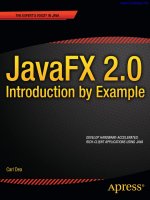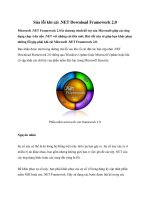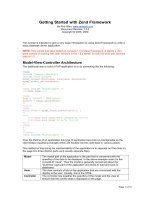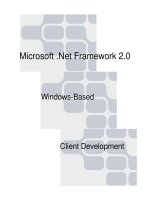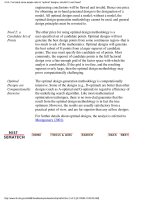Zend framework 2 0 by example
Bạn đang xem bản rút gọn của tài liệu. Xem và tải ngay bản đầy đủ của tài liệu tại đây (5.51 MB, 228 trang )
www.it-ebooks.info
Zend Framework 2.0 by Example
Beginner's Guide
A step-by-step guide to help you build full-scale web
applications using Zend Framework 2.0
Krishna Shasankar V
BIRMINGHAM - MUMBAI
www.it-ebooks.info
Zend Framework 2.0 by Example Beginner's Guide
Copyright © 2013 Packt Publishing
All rights reserved. No part of this book may be reproduced, stored in a retrieval system,
or transmitted in any form or by any means, without the prior written permission of the
publisher, except in the case of brief quotations embedded in critical articles or reviews.
Every effort has been made in the preparation of this book to ensure the accuracy of the
information presented. However, the information contained in this book is sold without
warranty, either express or implied. Neither the author, nor Packt Publishing, and its dealers
and distributors will be held liable for any damages caused or alleged to be caused directly or
indirectly by this book.
Packt Publishing has endeavored to provide trademark information about all of the
companies and products mentioned in this book by the appropriate use of capitals.
However, Packt Publishing cannot guarantee the accuracy of this information.
First published: July 2013
Production Reference: 1180713
Published by Packt Publishing Ltd.
Livery Place
35 Livery Street
Birmingham B3 2PB, UK.
ISBN 978-1-78216-192-9
www.packtpub.com
Cover Image by Abhishek Dhir ()
www.it-ebooks.info
Credits
Author
Project Coordinator
Krishna Shasankar V
Anugya Khurana
Reviewers
Proofreader
Wenbert S. Del Rosario
Maria Gould
Alex (Shurf) Frenkel
Islam Mohamed Abdel-aziz
Acquisition Editor
Abhinash Sahu
Lead Technical Editor
Neeshma Ramakrishnan
Veena Pagare
Priya Subramani
Graphics
Antony Lowe
Technical Editor
Indexer
Production Coordinator
Arvindkumar Gupta
Cover Work
Arvindkumar Gupta
www.it-ebooks.info
About the Author
Krishna Shasankar V is a web developer with 7 years of extensive development
experience in PHP. He leads a team of engineers at Lister Technologies developing
enterprise class retail and e-commerce solutions.
He is a Zend Certified Engineer in PHP 5 and Zend Framework. He also has a Bachelor's
degree in Information Technology from Anna University, Chennai, and a Master's degree
in Software Systems from Birla Institute of Technology and Science, Pilani.
In his spare time, he enjoys music, photography, and travel (especially when combined). You
can contact Krishna and leave some comments on his blog (www.clickoffline.com).
I would like to thank my parents, my brother, and all my friends who
encouraged and supported me throughout my life.
Thanks to Mukund Deverajan for his full and enthusiastic support, without
which, this book would not have existed. Thanks to Apoorv Bhargava,
Jayabharathi and Souvik Sengupta for motivating me and helping me
rework a majority of the book's content. Special thanks to my amazing
team at Lister Technologies for their wonderful support and all the fun.
You guys are awesome!
Thanks to the reviewers Wenbert S. Del Rosario, Alex (Shurf) Frenkel, and
Islam Mohamed Abdel-aziz for providing me with valuable feedback during
the review stages.
Finally, the awesome team, Antony Lowe, Neeshma Ramakrishnan, Veena
Pagare, and everyone else at Packt Publishing who had contributed to this
book, ensuring quality at each level. I am indebted to Anugya Khurana at
Packt Publishing, without her patience and persistence, this book would
have stalled many times. Special thanks to Veena Manjrekar for giving me
this opportunity, for which I am grateful.
www.it-ebooks.info
About the Reviewers
Wenbert Del Rosario is a web developer with a couple of years of experience working
with open source technologies (Linux, CakePHP, Code Igniter, MySQL, jQuery, Knockout JS,
and WordPress). In his free time, he loves to work on personal projects. He also does some
freelance and consulting work.
Wenbert has also reviewed a couple of books for Packt Publishing:
Zend Framework 1.8 Web Application Development Keith Pope
CouchDB and PHP Web Development Beginner's Guide, Tim Juravich
He shares his ideas, solutions, and day-to-day encounters at work through his blog at
. You can also follow him on Twitter @wenbert.
For Noeme and our baby Lucas.
www.it-ebooks.info
Alex Frenkel has been working in the field of web application development since 1998
(the beginning of PHP 3.X) and has extensive experience in system analysis and project
management. Alex is a PHP 5.3 Zend Certified Engineer and is considered to be one of
the most prominent LAMP developers in Israel.
In the past, Alex was the CTO of ReutNet, one of the leading Israeli web technology
based companies, and also worked as the CEO/CTO of OpenIview LTD., a company built
around an innovative idea of breaching IBM Mainframe business with PHP applications.
He also provided expert consulting services to different companies in various aspects of
web-related technology.
Alex is a CTO of a startup called GBooking and the owner of a small consulting company,
Frenkel-Online.
GBooking allows consumers to search, compare, and book a wide range of services on the
Web, while optimizing prices according to the demand, creating discounts during the weak
hours of businesses and propagating them to partners' sites.
Frenkel-Online is a project-based company, working with a number of professional
freelance consultants in Israel and abroad. Currently their permanent staff comprises of
several consultants in Israel and abroad for the company's PHP projects, and an altering
number of specialists in other programming languages for the rest of the projects.
www.it-ebooks.info
Islam Abdel-Aziz is a senior open source software engineer, and Zend Framework
contributor. He has been a Zend Certified Engineer since 2009.
Islam spent 9 years teaching and consulting on the latest web and enterprise technologies.
He is involved in development techniques, including the NO-SQL databases, the scalability of
the web, parallel/distributed processing using map/reduce model.
He has contributed to many open source projects in the last 7 years, and he has experience
in most open source technologies including PHP5, Python, and Java.
Islam joined Oracle in 2008 as a senior software engineer. He was one of the team for
developing the most stable cloud-computing platform in Python.
Islam currently holds the title of Arabic Team Lead in the ADVFN, the most popular financial
software company in UK. He is the one who is responsible for the engineering of ME versions
of the ADVFN products.
I would like to thank my wife for standing by me while I reviewed this book.
www.it-ebooks.info
www.PacktPub.com
Support files, eBooks, discount offers and more
You might want to visit www.PacktPub.com for support files and downloads related to
your book.
Did you know that Packt offers eBook versions of every book published, with PDF and ePub
files available? You can upgrade to the eBook version at www.PacktPub.com and as a print
book customer, you are entitled to a discount on the eBook copy. Get in touch with us at
for more details.
At www.PacktPub.com, you can also read a collection of free technical articles, sign up
for a range of free newsletters and receive exclusive discounts and offers on Packt books
and eBooks.
TM
Do you need instant solutions to your IT questions? PacktLib is Packt's online digital book
library. Here, you can access, read and search across Packt's entire library of books.
Why Subscribe?
Fully searchable across every book published by Packt
Copy and paste, print and bookmark content
On demand and accessible via web browser
Free Access for Packt account holders
If you have an account with Packt at www.PacktPub.com, you can use this to access
PacktLib today and view nine entirely free books. Simply use your login credentials for
immediate access.
www.it-ebooks.info
www.it-ebooks.info
www.it-ebooks.info
To my parents Paramajothi and Anuragalatha whose unconditional love and
sacrifice resulted in where I stand today.
www.it-ebooks.info
www.it-ebooks.info
Table of Contents
Preface1
Chapter 1: Getting Started with Zend Framework 2.0
7
Zend Framework 2.0
Introduction to Zend Server Community Edition (CE)
Zend Server CE – system requirements
Time for action – installing Zend Server CE
Configuring Zend Server CE
7
8
8
8
11
Time for action – configuring Zend Server CE
MySQL
Time for action – installing MySQL
12
14
15
Time for action – creating a database
Summary
16
20
Zend Server CE – Administration Interface
phpMyAdmin
Chapter 2: Building Your First Zend Framework Application
Prerequisites
ZendSkeletonApplication
Time for action – creating a Zend Framework project
Zend Framework 2.0 – modules
Zend Framework 2.0 – project folder structure
Time for action – creating a module
MVC layer
Zend Framework module – folder structure
Time for action – creating controllers and views
Zend Framework module – configuration
Time for action – modifying module configuration
Summary
www.it-ebooks.info
11
16
21
21
22
22
27
28
29
30
31
31
33
34
38
Table of Contents
Chapter 3: Creating a Communication Application
39
Chapter 4: Data Management and Document Sharing
59
Chapter 5: Chat and E-mail
83
Zend\Form
Time for action – creating a registration form
Form validation
Zend\InputFilter
Time for action – adding validation to the registration form
Models and database access
TableGateway
Time for action – creating models and saving the form
Zend\Authentication
Time for action – user authentication
Summary
Zend Framework 2 ServiceManager
Time for action – migrating existing code to ServiceManager
Database operations
More on TableGateway
Time for action – implementing an admin UI to manage users
Document management
Time for action – creating a file upload form
Managing file sharing
Time for action – implementing a file sharing system
Summary
Layouts and views
View helpers
39
40
46
46
47
50
50
51
55
56
58
59
61
63
64
65
71
71
76
76
82
83
84
The URL helper
The BasePath helper
The JSON helper
Concrete placeholder implementations
The HeadLink helper
The HeadMeta helper
The HeadScript helper
The HeadStyle helper
The HeadTitle helper
Time for action – using jQuery UI in a simple page
Building a simple group chat
Time for action – creating a simple group chat application
Sending mails
Zend\Mail\Transport
Zend\Mail\Message
Zend\Mime\Message and Zend\Mime\Part
[ ii ]
www.it-ebooks.info
84
85
85
85
85
86
86
87
87
88
90
90
95
96
96
96
Table of Contents
Time for action – creating a simple e-mail form
Zend\EventManager
Time for action – setting module layout using ZF events
Summary
97
99
100
103
Chapter 6: Media Sharing
105
Chapter 7: Search Using Lucene
123
Chapter 8: Creating a Simple Store
139
External modules
Resizing images
Time for action – resizing images using modules
The Photo gallery application
Time for action – implementing a simple photo gallery
Google Data APIs
The Google Photos API
Time for action – fetching photos from Google Photos
YouTube Data API
Time for action – listing YouTube videos for a keyword
Summary
Introduction to Lucene
Time for action – installing ZendSearch\Lucene
Indexing
Time for action – generating a Lucene index
Searching
Time for action – displaying search results
Indexing Microsoft Office documents
Time for action – indexing document files
Summary
Shopping cart
Time for action – creating a store front
The store administration
Time for action – creating the Store Admin interface
Payments with PayPal
PayPal and Zend Framework 2.0
Time for action – setting up PayPal
PayPal Express Checkout
Time for action – accepting payments using PayPal
Summary
[ iii ]
www.it-ebooks.info
105
106
106
108
109
113
114
115
119
119
122
123
124
125
127
129
130
133
134
137
140
140
143
144
146
146
147
149
150
157
Table of Contents
Chapter 9: HTML5 Support
159
Chapter 10: Building Mobile Applications
177
Appendix: Pop Quiz Answers
195
Index
199
HTML5 input elements
Time for action – HTML5 input elements
HTML5 view helpers
Time for action – HTML5 view helpers
HTML5 attributes
Multiple file uploads
Time for action – HTML5 multiple file uploads
Summary
Cloud-connected mobile applications
Zend Studio 10
phpCloud
Time for action – configuring your phpCloud account
PhoneGap and Zend Studio
Time for action – building your first cloud-connected mobile application
Native applications versus mobile web applications
Time for action – testing as a native application
Zend Server Gateway
Time for action – creating a mobile search interface
Summary
Chapter 1, Getting Started with Zend Framework 2.0
Chapter 2, Building Your First Zend Framework Application
Chapter 3, Creating a Communication Application
Chapter 4, Data Management and Document Sharing
Chapter 5, Chat and E-mail
Chapter 6, Media Sharing
Chapter 7, Search Using Lucene
Chapter 8, Creating a Simple Store
Chapter 9, HTML5 Support
Chapter 10, Building Mobile Applications
[ iv ]
www.it-ebooks.info
160
165
167
168
171
172
172
176
177
178
178
178
182
182
186
187
190
190
193
195
195
195
196
196
196
196
197
197
197
Preface
Zend Framework 2 is the latest update to the well-known Zend Framework. This version
has considerably eased the process of building complex web applications with minimal
development effort using plug and play components. Zend Framework 2 also provides a
highly robust and scalable framework for developing web applications.
This book will guide you through the process of developing powerful web applications using
ZF2. It covers all aspects of Zend Framework application development right from installation
and configuration; the tasks are designed in a way that readers can easily understand and
use them to build their own applications with ease.
This book begins with basic installation and configuration of the Zend Framework. As you
progress through the exercises, you will become thoroughly acquainted with ZF2. With
this book, you will learn about the basic concepts of building solid MVC web applications
using Zend Framework 2. The detailed step-by-step instructions will enable you to build
functionality such as a group chat, a file and media sharing service, search, and a simple
store, to name a few. You will also use a wide range of external modules to implement
features that are not natively available.
By the end of the book, you will be well versed in building complex and functionality-rich
web applications using Zend Framework 2.
What this book covers
Chapter 1, Getting Started with Zend Framework 2.0, introduces you to the configuration of
the development environment. In this chapter, we will set up a PHP application server, install
MySQL, and create a development database which will be used in subsequent chapters for
our Zend Framework learning exercises.
www.it-ebooks.info
Preface
Chapter 2, Building Your First Zend Framework Application, explains the creation of the Zend
Framework 2 project; we will be reviewing some of the key aspects of building a ZF2 MVC
application by creating modules, controllers, and views. We will be creating our own custom
module in Zend Framework which will be enhanced further in subsequent chapters of
this book.
Chapter 3, Creating a Communication Application, introduces you to Zend\Form. In this
chapter we will create our first registration form, and set up login and authentication for
registered users using Zend Framework components.
Chapter 4, Data Management and Document Sharing, covers some of Zend Framework's
data and file management concepts. In this chapter, we will learn various aspects of Zend
Framework including ServiceManager, the TableGateway pattern, handling uploads, and
file sharing.
Chapter 5, Chat and E-mail, covers the use of JavaScript in your application. This chapter uses
a simple group chat implementation as an example for explaining the usage of JavaScript in
your applications; you will also be introduced to sending e-mails using Zend\Mail and the ZF2
event manager.
Chapter 6, Media Sharing, explains the management and sharing of images and videos using
Zend Framework. In this chapter, we will use of various external Zend Framework 2 modules
to work with images and videos.
Chapter 7, Search using Lucene, introduces you to the Lucene search implementation
using Zend Framework. This chapter begins by explaining the users about the installation
of ZendSearch\Lucene module, we then cover the details of implementing search for
database records and also document files.
Chapter 8, Creating a Simple Store, introduces you to e-commerce. In this chapter, we will
be building a simple online store to demonstrate the process involved in development of
a shopping cart. We will be using PayPal Express Checkout as our payment processer in
this chapter.
Chapter 9, HTML5 Support, introduces you to HTML5 support in Zend Framework 2. When
compared to the previous version, ZF2 offers exhaustive support for various HTML5 features;
this chapter covers two major aspects of ZF2's HTML5 support—new input types and
multiple file uploads.
Chapter 10, Building Mobile Applications, introduces you to the development of native
mobile applications with the help of Zend Framework 2 and Zend Studio 10. In this chapter,
we will learn the fundamentals of building cloud-connected mobile applications using Zend
Framework; we will also learn about the setup of Zend PHP developer cloud environment.
[2]
www.it-ebooks.info
Preface
What you need for this book
You will need a system that is capable of running Zend Server CE along with MySQL.
The prerequisite software that is required for working with tasks to be performance
in the book is covered in Chapter 1, Getting Started with Zend Framework 2.0.
Who this book is for
If you are a PHP developer who is new to Zend Framework, but you want to get hands-on with
the product quickly, this book is for you. Basic knowledge of object-oriented programming with
PHP is expected.
Conventions
In this book, you will find several headings appearing frequently.
To give clear instructions of how to complete a procedure or task, we use:
Time for action – heading
1.
2.
3.
Action 1
Action 2
Action 3
Instructions often need some extra explanation so that they make sense, so they are
followed with:
What just happened?
This heading explains the working of tasks or instructions that you have just completed.
You will also find some other learning aids in the book, including:
Pop quiz – heading
These are short multiple-choice questions intended to help you test your own understanding.
[3]
www.it-ebooks.info
Preface
Have a go hero – heading
These practical challenges give you ideas for experimenting with what you have learned.
You will also find a number of styles of text that distinguish between different kinds of
information. Here are some examples of these styles, and an explanation of their meaning.
Code words in text are shown as follows: "The TableGateway class extends
AbstractTableGateway which implements TableGatewayInterface."
A block of code is set as follows:
// Add Document to index
$indexDoc = new Lucene\Document();
$indexDoc->addField($label);
$indexDoc->addField($owner);
$indexDoc->addField($fileUploadId);
$index->addDocument($indexDoc);
}
// Commit Index
$index->commit();
When we wish to draw your attention to a particular part of a code block, the relevant lines
or items are set in bold:
// Add Document to index
$indexDoc = new Lucene\Document();
$indexDoc->addField($label);
$indexDoc->addField($owner);
$indexDoc->addField($fileUploadId);
$index->addDocument($indexDoc);
}
// Commit Index
$index->commit();
Any command-line input or output is written as follows:
$ sudo apt-get install php5-cli
$ sudo apt-get install git
$ curl -s | php
New terms and important words are shown in bold. Words that you see on the screen, in
menus or dialog boxes for example, appear in the text like this: "On the Select Destination
Location screen, click on Next to accept the default destination."
[4]
www.it-ebooks.info
Preface
Warnings or important notes appear in a box like this.
Tips and tricks appear like this.
Reader feedback
Feedback from our readers is always welcome. Let us know what you think about this
|book—what you liked or may have disliked. Reader feedback is important for us to
develop titles that you really get the most out of.
To send us general feedback, simply send an e-mail to , and
mention the book title through the subject of your message.
If there is a topic that you have expertise in and you are interested in either writing or
contributing to a book, see our author guide on www.packtpub.com/authors.
Customer support
Now that you are the proud owner of a Packt book, we have a number of things to help you
to get the most from your purchase.
Downloading the example code
You can download the example code files for all Packt books you have purchased from
your account at . If you purchased this book elsewhere,
you can visit and register to have the files
e-mailed directly to you.
[5]
www.it-ebooks.info
Preface
Errata
Although we have taken every care to ensure the accuracy of our content, mistakes do
happen. If you find a mistake in one of our books—maybe a mistake in the text or the
code—we would be grateful if you would report this to us. By doing so, you can save other
readers from frustration and help us improve subsequent versions of this book. If you find
any errata, please report them by visiting />selecting your book, clicking on the errata submission form link, and entering the details of
your errata. Once your errata are verified, your submission will be accepted and the errata
will be uploaded to our website, or added to any list of existing errata, under the Errata
section of that title.
Piracy
Piracy of copyright material on the Internet is an ongoing problem across all media. At Packt,
we take the protection of our copyright and licenses very seriously. If you come across any
illegal copies of our works, in any form, on the Internet, please provide us with the location
address or website name immediately so that we can pursue a remedy.
Please contact us at with a link to the suspected pirated material.
We appreciate your help in protecting our authors, and our ability to bring you valuable content.
Questions
You can contact us at if you are having a problem with any
aspect of the book, and we will do our best to address it.
[6]
www.it-ebooks.info
1
Getting Started with
Zend Framework 2.0
In this chapter we will get our development environment set up and configured
in order to start development with Zend Framework 2.0. We will set up a PHP
Application Server, install MySQL, and create a development database that will
be used in subsequent chapters for our Zend Framework learning exercises. So,
let's get started.
Zend Framework 2.0
The last major release of Zend Framework, which happened in 2007, was version 1.0;
during the last five years, Zend Framework has undergone a lot of changes to be a
successful PHP-based framework. But by merely updating the framework, Zend Framework
has retained some of the issues that were inherently present in Zend Framework 1.0.
Zend Framework 2.0 is an attempt to make Zend Framework better by rearchitecting the
framework right from the core. Some of the key features of Zend Framework 2.0 over its
previous version are listed as follows:
PHP 5.3 features such as namespaces and closures
A modular application architecture
Event manager
Dependency Injection (DI)
We will get to know about implementing the new features of Zend Framework 2.0 in the
coming chapters.
www.it-ebooks.info
Getting Started with Zend Framework 2.0
In this chapter we will cover the installation and configuration of some of the prerequisites
of Zend Framework 2.0. ZF2 can be installed on most PHP-enabled web servers that support
PHP 5.3.3 or later.
We have used Zend Server Community Edition as our default web server; however, any other
PHP stack that supports PHP 5.3.3 can be used. Alternatively, you can also download Apache
and PHP separately and install PHP over Apache.
To simplify the installation process, I am using Linux as the primary development
environment in this book. All the tools used in this book are available for Windows
and can be used to perform the same activity.
Introduction to Zend Server Community Edition (CE)
Zend Server Community Edition is the free version of the popular Zend Server stack. The
Zend Server stack provides a pre-integrated PHP application stack that could be used across
development, testing, and production. This enables application development teams to have
a consistent environment across all stages of development.
Zend Server CE also provides features such as Zend Optimizer+ for PHP bytecode caching and
Zend Guard for encoding files.
Zend Server CE – system requirements
Zend Server offers installers for Windows, Mac OS X, and a universal installation package
compatible with most Linux distributions.
More details on the installation requirements can be found at />
products/server/system-requirements.
Time for action – installing Zend Server CE
Our next step will be to download and install Zend Server CE; I am running Ubuntu 12.04
Precise Pangolin. The installation procedure for other operating systems could be different;
you can always refer to the Zend Server website for installation instructions. The following
are the steps to install the Zend Server CE:
1.
Visit the Zend Server Community Edition website ( />community/zend-server-ce) and download the latest version of Zend Server
that is applicable to your operating system. In this case, we will be downloading the
Linux installer.
[8]
www.it-ebooks.info



